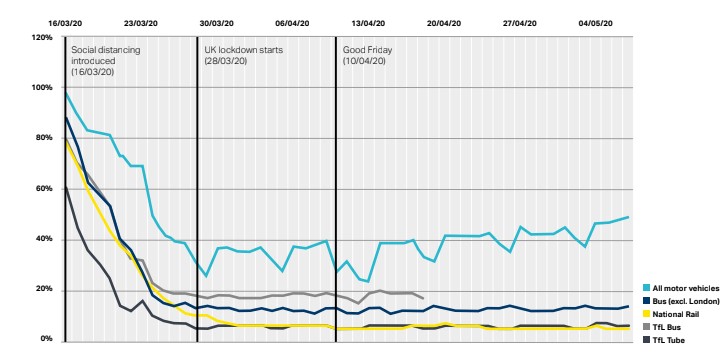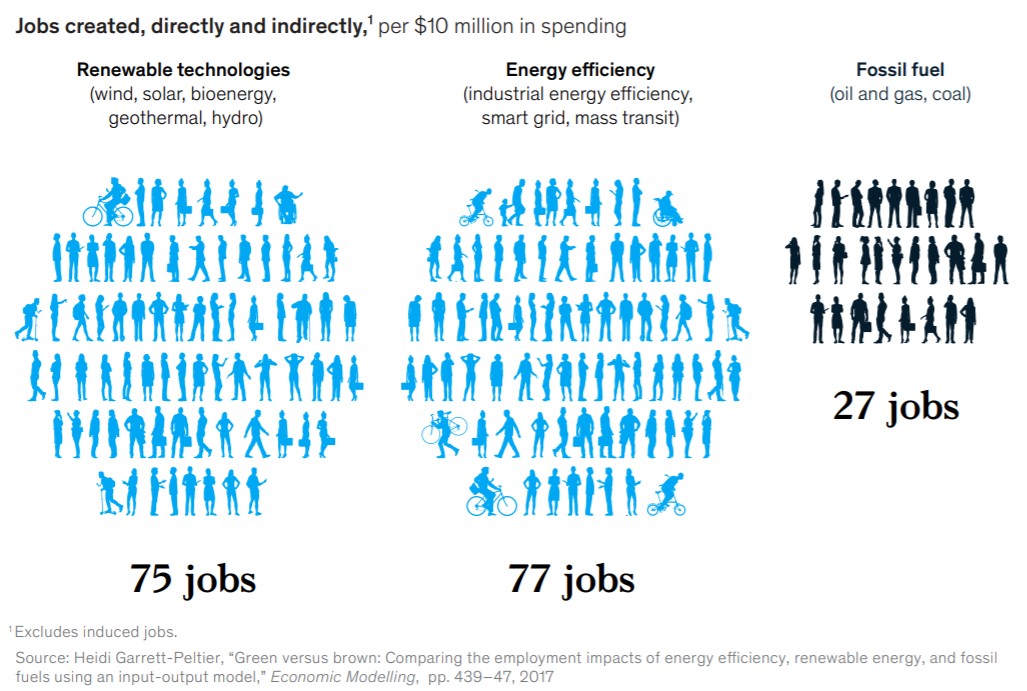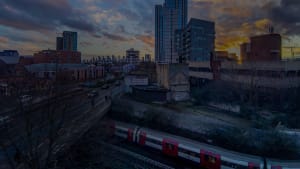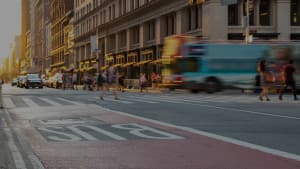Foreseeable futures: the power of logic mapping
The Future of Infrastructure
Decision-making and planning through the coronavirus uncertainty requires bold leadership and an understanding that there are many possible versions of the future. Scenario planning and logic mapping can help policy-makers lock in environmental, social and economic benefits says transport planning specialist Peter Wright.
“Does it look clearer with lens one or lens two?” It’s a common question to hear at the opticians but it chimes with the challenges faced by transport planners as we emerge from lockdown and map the future of infrastructure networks. Pre-lockdown, we could leave the house and go wherever we wanted, whenever we wanted, with whoever we wanted, but circumstances – and mobility – has changed. So, what lenses should we look through to plan for possible futures? In these uncertain times, scenario planning and logic mapping are powerful tools that balance desired economic, social and environmental priorities while emphasising unwanted or unintended outcomes.
During the initial weeks of the coronavirus pandemic, graphs showing the daily movements of people by different modes of transport were regularly featured on prime time national television during daily briefings by the Prime Minister and Chief Medical Officers. The clarity of figures provided by the Department for Transport – 90-95 per cent reduction in use of rail and underground, 80 per cent or more reduction in bus patronage and a 75 per cent drop in motor vehicles usage – were startling and showed us all just how fundamentally life as we know it has changed; much of it before the government imposed lockdown (See Figure 1).
Data on travel behaviour has never been so prevalent and this has enabled us to see how patterns of movement were changing across the globe. What is clear is that whilst the patterns are similar in many ways – from lockdown imposed, through reduction in travel, to lockdown release with reduced use of public transport and increased travel by private vehicles – there are differences in approaches by national governments, cities, individuals and communities that have led to different choices and behavioural responses. Now, as the world transitions from lockdown, there is an opportunity to look at the choices and behavioural responses through complementary lenses to prepare for what comes next.
Decision-making and planning through the coronavirus uncertainty requires bold leadership WHO says poor global leadership is making pandemic worse
and an understanding that there are many possible versions of the futureMcKinsey: Getting ahead of the next stage of the coronavirus crisis
. This article explains why scenario planning and logic mapping are powerful tools that can help shape decision-making while informing policy decisions and strengthening leadership at the same time.

Figure 1: Use of transport modes in Great Britain between March 16th and May 4th 2020. (Source: Transport for London)
What is logic mapping and why is it relevant now?
Logic mapping has been used for some time in programme planning and transport evaluation. It is a “systematic and visual way of presenting the key steps required in order to turn a set of resources or inputs into activities that are designed to lead to a specific set of changes or outcomes”UK Government: Logic mapping
. It is not rigid or prescribed, but an iterative and flexible way of communicating choices and impacts – intended and otherwise – to achieve a series of objectives.
As society and businesses increase levels of activity, transport commentators and advisors have spoken of the chance to return to a “new normal” where the “good behaviours” of lockdown are maintainedAECOM: Harnessing lasting climate benefits from lockdown
Nature: Temporary reduction in daily global CO2 emissions
. However, to capitalise on the momentum offered by changes in working patterns and more local travel horizons, we need to plan for scenarios where the economic recovery is viewed through environmental and social lenses. While there are obvious advantages if trajectories are aligned between businesses and operators, as well as national and local government, logic mapping helps ensure that any desired objectives are viewed alongside any unintended or unwanted consequences.
Cornwall Council: using logic mapping to tackle coronavirus while addressing climate change
Cornwall Council, along with all the authorities in South West England, declared a Climate Emergency in 2019 – with the ambition of becoming carbon neutral by 2030Cornwall Council: Climate Emergency Action Plan
. Cornwall made a commitment to act as it has an extensive coastline and is more vulnerable to the impacts of climate change than many parts of the UK including flooding, rising sea-levels and susceptible infrastructure. Now, as Cornwall emerges from lockdown, AECOM is working with the council to ensure that plans to address the recovery from coronavirus are underpinned by their transport, development and economic actions to address climate change. What they and other authorities and businesses do now will influence the local (and global) CO2 emissions path for decadesNature Climate Change: Temporary reduction in daily global CO2
.
In its Climate Emergency Action Plan, Cornwall Council has stated that actions to meet the objective of net zero by 2030 should also address increasing inequalities, poverty and health of individuals and their communities. Furthermore, they recognise that the short- and medium-term actions and economic incentives to aid the recovery from coronavirus could, if not addressed, have longer-term impacts on achieving their Climate Emergency objectives.
Cornwall Council is now using logic mapping to explore mobility options (not just transport) and their possible consequences whilst responding to coronavirus and aiding transport recovery. This includes (re)launching their “Superbus” fares pilotUK Government: A better deal for bus users
and Transport for Cornwall as and when it is safe to encourage more people to use public transport. Logic mapping allows them to respond to the current constraints whilst keeping focus on their original objectives of creating “a step change in public transport through improvements in local bus patronage” as well as mitigating the effects of climate change, by reducing congestion and improving air quality in addition to increasing people’s activity levels. Rather than indefinitely delaying spending the £23.5m pilot funding allocated for reducing bus fares in the county, AECOM and Cornwall Council are using logic mapping to redesign the scheme to deliver against the original objectives with the additional requirements and evaluation associated with coronavirus restrictions. This means planning for futures where a choice now does not prevent something happening in the future or is irreversible against a set of recognised objectives, giving a wider awareness to how interventions can complement and facilitate one another.
Changing the ways that we measure success
Traditionally, appraisal in infrastructure is driven by measures of economic performance, particularly in transport. Adapting to the challenges and capitalising on the opportunities offered requires a change in the ways we measure success – logic mapping helps to do this. Without amending our evaluation frameworks we could slip back to what we know best (carbon-emitting industries) and a greater inequality in a post-crisis world, with the poorest hit hardest. We should not rebuild as we have in the past – instead, if we focus on rebuilding with cleaner energy and sustainable infrastructure, there are potentially bigger benefits for the economy and more job creation – something that will underpin social recovery (see Figure 2).

Figure 2: Jobs created, directly and indirectly, by spending on energy efficient, renewable technology and fossil fuel industries (Source: McKinsey & Company)
London is already ahead of the curve in this regard. In the short- to medium-term Transport for London (TfL) has taken the bold steps to not only provide more space for walking and cycling through the Streetspace for London programme but they have also extended the operation and increased the price of the Congestion Charge to ensure that the newfound roadspace is locked in Understanding and managing congestion in London
sending a clear signal to business and residents that people are central to the futures London is creating. Furthermore, the London Plan’s Sustainable Infrastructure policies requires building infrastructure within a circular economy, minimising waste and reducing impacts on the environment at the same time.
taking advantage of once in a lifetime opportunity
We may never have a better opportunity to plan transport and cities with the environment and society engaged as part of the process. As Manchester’s first Cycling and Walking Commissioner and Olympic gold medallist Chris Boardman recently said with regard to locking in the good behaviours that emerged from the coronavirus restrictions, “this is a once in a lifetime opportunity, probably multiple lifetimes… In a sense it is an emergency situation.”AECOM’s Talking infrastructure podcast – Manchester: how to deliver a clean, green and more liveable city post lockdown (April 2020)
.
Whilst there is a pressure and an imperative to react quickly, scenario planning and logic mapping allow us to plan for futures where the benefits can be felt in the immediate and near-terms, without compromising the rights and opportunities of future generations. It’s as close as we get to a crystal ball.
This article first appeared in Smart Transport Magazine
-
ArticleTomorrow, Workplace
![]()
Calling time on rush hour in a post-pandemic world
Changing behavior in transport
Coronavirus restrictions are not going to end suddenly. As restrictions are eased and people return to work, we will need a new approach to transport.Calling time on rush hour in a post-pandemic worldCoronavirus restrictions are not going to end suddenly. As restrictions are eased and people return to work, we will need a new approach to transport. -
ArticleSocial, Future
![]()
Social impact: Building a better case for infrastructure Investment
Measuring social impact
As we look towards recovery, there’s a danger that economic concerns dominate infrastructure decisions. To support those most hurt by coronavirus, social impact should be a key driver for investment.Social impact: Building a better case for infrastructure InvestmentAs we look towards recovery, there’s a danger that economic concerns dominate infrastructure decisions. To support those most hurt by coronavirus, social impact should be a key driver for investment. -
ArticleTomorrow
![]()
Post pandemic: our cities will continue to thrive
Three responses cities can embrace to grow back better
The pandemic of 2020 has posed an incredible challenge for our cities, affecting how people live, work and socialise within them. As restrictions ease, some are questioning how these changes – some of which will be permanent - will shape the pull of cities. We identify three ways of ensuring our urban places continue to be vibrant, thriving spaces.Post pandemic: our cities will continue to thriveThe pandemic of 2020 has posed an incredible challenge for our cities, affecting how people live, work and socialise within them. With the right planning and investments, they can grow back stronger.






